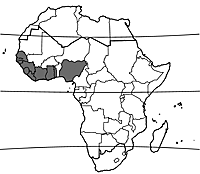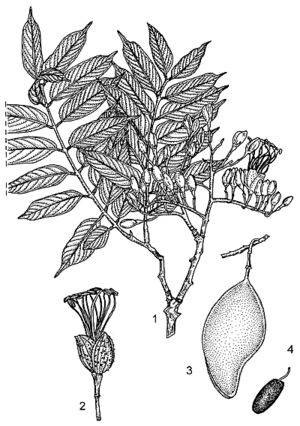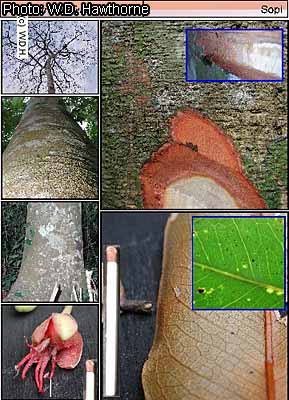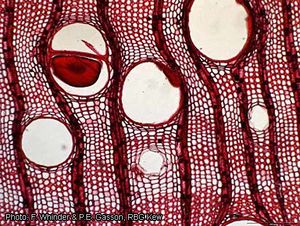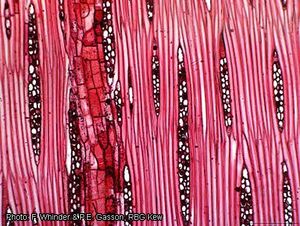Daniellia thurifera (PROTA)
Introduction |
| General importance | |
| Geographic coverage Africa | |
| Geographic coverage World | |
| Vegetable oil | |
| Essential oil / exudate | |
| Medicinal | |
| Timber | |
| Fuel | |
| Ornamental | |
| Fibre | |
Daniellia thurifera Benn.
- Protologue: Pharm. Journ. Trans. 14: 253 (1854).
- Family: Caesalpiniaceae (Leguminosae - Caesalpinioideae)
Vernacular names
- Copal tree, frankincense tree, gum copal, Niger copal, Sudan copal (En).
- Acacia copal do Sudão (Po).
Origin and geographic distribution
Daniellia thurifera occurs from Senegal east to western Nigeria.
Uses
The aromatic wood of Daniellia thurifera, traded as ‘faro’ and ‘daniellia’, is used for light construction, planks, light flooring, joinery, interior trim, boat building, furniture, toys, novelties, boxes, crates, agricultural implements, draining boards, turnery, hardboard and particle board. It is suitable for veneer, plywood and pulpwood, as well as firewood and charcoal production.
Beehives are made from the bark. The twigs are used as chew sticks. The tree yield a resin or gum, known as ‘gum copal’ and used for cosmetics, perfume, pomades, varnish, soap and fumigation. The gum is rubbed on the body for its fragrance, usually mixed with clay, and it can be used to mend broken pottery. The seeds yield a clear oil, which is made in Liberia into a hair dressing.
In Ghana a decoction prepared from the powdered gum is taken by the Krobo people to treat cough. The gum is used as embrocation to treat skin diseases, including ringworm. In Sierra Leone Daniellia thurifera is planted as ornamental tree along roadsides. The gum is burnt to keep away evil spirits.
Production and international trade
In 1983 Côte d’Ivoire exported 73,000 m³ of logs of faro (Daniellia spp.). Currently Daniellia thurifera and other Daniellia spp. have no importance on the international timber market, but their wood is commonly used locally in West Africa.
Properties
The heartwood is pale pinkish brown to reddish brown with dark streaks and is distinctly demarcated from the wide, whitish or pale yellow sapwood. The grain is interlocked, texture medium coarse. The wood is strongly scented and has lustrous and oily surfaces.
The wood is lightweight to medium-weight, with a density of 490–660 kg/m³ at 12% moisture content, moderately soft but tough and strong. It air dries easily, although in thick boards there might be slight distortion and collapse. The shrinkage rates are moderate, from green to oven dry 2.6–4.5% radial and 5.6–8.2% tangential. Kiln drying is fairly fast with little degrade. Once dry, the wood is moderately stable in service. At 12% moisture content, the modulus of rupture is 66–122 N/mm², modulus of elasticity 8130–9220 N/mm², compression parallel to grain 30–46 N/mm², shear 6.5–7 N/mm², cleavage 11–18 N/mm, Janka side hardness 5560 N, Janka end hardness 6850 N and Chalais-Meudon side hardness 1.2–3.8.
The wood is easy to saw and work with both hand and machine tools, with little blunting effect on saw teeth and cutting edges. Worked surfaces tend to be woolly, so cutting edges must be kept sharp. Although the wood planes smoothly, tearing of quarter-sawn surfaces due to interlocked grain may occur and a reduced cutting angle of 20° is recommended. The wood stains satisfactorily but needs a filler before polishing. It nails well and glues correctly. It can be readily peeled into veneer, but gluing of veneer can be difficult due to warping during drying. The wood is not durable, being susceptible to attacks by fungi, termites, pinhole borers and Lyctus. The heartwood is moderately resistant to impregnation, but the sapwood is easy to treat with preservatives.
The wood contains 42–43% cellulose, 27.5–29% lignin, 19–19.5% pentosan and 1.0–1.1% ash. The solubility is 2.5–2.8% in alcohol-benzene, 2.5–3.1% in hot water and 18. 0–20.4% in a 1% NaOH solution.
The resin from the heartwood is dark brown, oily and sticky, and can be saponified, although it has a low saponification value. One of the main compounds of the gum is the diterpene oleoresin daniellic acid (illurinic acid), as well as ozic acid and the alcohol ozol.
Adulterations and substitutes
The wood of Daniellia thurifera is similar to that of Daniellia ogea (Harms) Rolfe ex Holland and Daniellia klainei Pierre ex A.Chev., and has similar uses.
Description
- Deciduous, medium-sized to fairly large tree up to 35(–45) m tall; bole straight and cylindrical, up to 150 cm in diameter, without buttresses; bark surface smooth becoming scaly in older trees, greyish white or greenish with horizontal brownish bands, inner bark thick, orange brown to reddish brown; crown dense, wide, flattened; twigs glabrous.
- Leaves alternate, paripinnately compound with 5–9 pairs of leaflets; stipules up to 10(–15) cm × 1(–1.5) cm, soon falling; petiole 1.5–3.5(–5.5) cm long, rachis (10–)13–17(–27) cm long, shallowly channelled, at least at base, with small glands at insertion of basal pair of leaflets; petiolules 4.5–8 mm long; leaflets opposite, ovate-elliptical to oblong-lanceolate, up to 12(–18) cm × 6 cm, basal and apical leaflets smaller than middle ones, base cuneate, asymmetrical, apex acuminate, papery to leathery, glabrous, with many translucent glandular dots, pinnately veined with 10–25 pairs of lateral veins.
- Inflorescence an axillary or terminal compound raceme (6–)9–11(–15) cm long, glabrous, with 6–10 lateral branches.
- Flowers bisexual, zygomorphic, slightly scented; pedicel 8–11(–17) mm long, glabrous, enlarging in fruit, near the middle with 2 caducous bracteoles; sepals 4, oblong, 1.5–2 cm long, glabrous but margins hairy, with few gland dots on external surface; petals 5, white to yellowish, unequal, oblong to triangular, 3 petals 1–1.5 cm long and 2 petals 1–3 mm long, short-hairy to nearly glabrous, with few glandular dots; stamens 10, 3–4.5 cm long, 9 united at base and 1 free; ovary superior, oblong to rounded, 0.5–1 cm long, glabrous, with stipe c. 0.5 cm long, style up to 2.5 cm long.
- Fruit an obliquely oblong, flattened pod 7–9 cm × 3.5–5 cm, with stipe up to 1 cm long, glabrous, green becoming brown, dehiscing with 2 woody valves, 1-seeded.
- Seed oblong, flattened, 1.5–3 cm long, smooth, deep red to brown, attached to one of the valves by a c. 1.5 cm long funicle.
- Seedling with epigeal germination; hypocotyl 4–5 cm long, epicotyl c. 6 cm long, glabrous; cotyledons fleshy, oblong, 2.5–3 cm long, erect; first leaves alternate, with 2–3 pairs of leaflets.
Other botanical information
Daniellia comprises 10 species, which are nearly all confined to the forest areas of West and Central Africa, with only 1 species extending to Sudan and Uganda.
Anatomy
Wood-anatomical description (IAWA hardwood codes):
- Growth rings: 2: growth ring boundaries indistinct or absent.
- Vessels: 5: wood diffuse-porous; (9: vessels exclusively solitary (90% or more)); 13: simple perforation plates; 22: intervessel pits alternate; 23: shape of alternate pits polygonal; 27: intervessel pits large (≥ 10 μm); 29: vestured pits; 30: vessel-ray pits with distinct borders; similar to intervessel pits in size and shape throughout the ray cell; 43: mean tangential diameter of vessel lumina ≥ 200 μm; 46: ≤ 5 vessels per square millimetre; 58: gums and other deposits in heartwood vessels.
- Tracheids and fibres: 61: fibres with simple to minutely bordered pits; 66: non-septate fibres present; (68: fibres very thin-walled); 69: fibres thin- to thick-walled.
- Axial parenchyma: 78: axial parenchyma scanty paratracheal; 85: axial parenchyma bands more than three cells wide; (89: axial parenchyma in marginal or in seemingly marginal bands); 91: two cells per parenchyma strand; 92: four (3–4) cells per parenchyma strand.
- Rays: 97: ray width 1–3 cells; 106: body ray cells procumbent with one row of upright and/or square marginal cells; 107: body ray cells procumbent with mostly 2–4 rows of upright and/or square marginal cells; 115: 4–12 rays per mm.
- Storied structure: 118: all rays storied; 119: low rays storied, high rays non-storied; 120: axial parenchyma and/or vessel elements storied; 121: fibres storied.
- Secretory elements and cambial variants: 127: axial canals in long tangential lines; 129: axial canals diffuse.
Growth and development
Seedlings reach about 12 cm tall after 1.5 months and 15 cm tall after 2.5 months. In Guinea growth in the field has been reported to be quite slow; seedlings reached 35 cm in height after 1 year, 60 cm after 2 years and 150 cm after 5 years. In Liberia fruit bearing Daniellia thurifera trees of about 10 m tall were observed. The tree usually sheds its leaves at the end of the rainy season, and flowering occurs when the tree is leafless, mainly from August to January. Fruits ripen about 5 months after flowering. When the fruit dries, the two valves start to curl, releasing the seed, which remains attached to one of the valves by a long funicle. When the valve with the seed falls, it rotates rapidly and may be spread by wind far from the mother tree.
Ecology
Daniellia thurifera occurs in scattered groups in evergreen forest, in primary as well as secondary forest, sometimes also in gallery forest and wooded savanna, from sea-level up to 400 m altitude. It prefers damp areas but avoids swampy conditions.
Propagation and planting
Natural regeneration of Daniellia thurifera is abundant in forest gaps and disturbed forest, as it is a pioneer and light demander. There are 600–800 seeds per kg. The germination rate of fresh seeds is usually high, 50–95%, and germination starts about 2 weeks after sowing. Shading should be removed soon after germination. The seedlings are ready for planting into the field after one year in the nursery. In Guinea the mortality of seedlings planted in full sun was 50% after 5 years, but this was probably due to a lack of weeding after planting.
Management
In evergreen forest in Côte d’Ivoire, the average density of trees with a bole diameter of more than 90 cm was locally 10 trees/ha, and of saplings with a bole diameter of 10–20 cm about 20 per ha. In Sierra Leone plantations of Daniellia thurifera have been established. Systematic thinning of the forest was found to be beneficial in terms of recruitment and growth. However, the difference between heavy and light thinning was negligible, and the maximum recommended thinning intensity was 28% of the initial basal area (5–6 m²/ha removed).
Diseases and pests
Logs should be processed quickly after felling or treated with preservatives because the wood is susceptible to discoloration by blue-stain fungi and attacks by insects. Fallen seeds are often eaten by rodents.
Harvesting
Trees are harvested by the selective logging system; larger trees are occasionally defective. Some caution is needed during harvesting operations because logs may have brittle heart.
For harvesting of the gum a deep hole is cut near the base of the tree, and the exudate is collected. However, Daniellia thurifera does not yield commercial quantities of gum.
Genetic resources
Daniellia thurifera is fairly widespread and there are no indications of overexploitation; therefore it does not seem to be threatened by genetic erosion. However, it is probably much confused with other Daniellia spp., and therefore its exact status is not known.
Prospects
Daniellia thurifera has not been considered a timber tree of commercial importance because its wood is susceptible to fungal attacks and the gum may interfere with processing. However, it may have good prospects for the production of veneer and plywood. More information is needed on growth rates and methods to improve regeneration to be able to draw conclusions about possibilities for sustainable exploitation from natural forest. Further research of the exudate is needed on the possible usage in the varnish and cosmetic industry.
Major references
- Bolza, E. & Keating, W.G., 1972. African timbers: the properties, uses and characteristics of 700 species. Division of Building Research, CSIRO, Melbourne, Australia. 710 pp.
- Burkill, H.M., 1995. The useful plants of West Tropical Africa. 2nd Edition. Volume 3, Families J–L. Royal Botanic Gardens, Kew, Richmond, United Kingdom. 857 pp.
- CIRAD Forestry Department, 2009. Faro. [Internet] Tropix 6.0. http://tropix.cirad.fr/africa/faro.pdf. January 2012.
- Cooper, G.P. & Record, S.J., 1931. The evergreen forests of Liberia. School of Forestry, Yale University, Bulletin 31, New Haven, United States. 153 pp.
- de la Estrella, M., Aedo, C., Mackinder, B. & Velayos, M., 2010. Taxonomic revision of Daniellia (Leguminosae: Caesalpinioideae). Systematic Botany 35(2): 296–324.
- Hawthorne, W. & Jongkind, C., 2006. Woody plants of western African forests: a guide to the forest trees, shrubs and lianes from Senegal to Ghana. Kew Publishing, Royal Botanic Gardens, Kew, United Kingdom. 1023 pp.
- Hubert, D., undated. Sylviculture des essences de forêts denses humides d’Afrique de l’Ouest. 187 pp.
- Irvine, F.R., 1961. Woody plants of Ghana, with special reference to their uses. Oxford University Press, London, United Kingdom. 868 pp.
- Kryn, J.M. & Fobes, E.W., 1959. The woods of Liberia. Report 2159. USDA Forest Service, Forest Products Laboratory, Madison, Wisconsin, United States. 147 pp.
- Takahashi, A., 1978. Compilation of data on the mechanical properties of foreign woods (part 3) Africa. Shimane University, Matsue, Japan. 248 pp.
Other references
- ATIBT (Association Technique Internationale des Bois Tropicaux), 1986. Tropical timber atlas: Part 1 – Africa. ATIBT, Paris, France. 208 pp.
- CTFT (Centre Technique Forestier Tropical), 1955. Fiche botanique, forestière, industrielle et commerciale: Faro (Daniellia spp.). Bois et Forêts des Tropiques 44: 17–20.
- de la Mensbruge, G., 1966. La germination et les plantules des essences arborées de la forêt dense humide de la Côte d’Ivoire. Centre Technique Forestier Tropical, Nogent-sur-Marne, France. 389 pp.
- Durrieu de Madron, L., Favrichon, V., Dupuy, B., Bar-Hen, A. & Maître, H.-F., 1998. Croissance et productivité en forêt dense humide: bilan des expérimentations dans le dispositif d’Irobo, Côte d’Ivoire (1978–1990). Document Forafri 2. Cirad, Montpellier, France. 69 pp.
- Gérard, J., Edi Kouassi, A., Daigremont, C., Détienne, P., Fouquet, D. & Vernay, M., 1998. Synthèse sur les caractéristiques technologiques des principaux bois commerciaux africains. Document Forafri 11. Cirad, Montpellier, France. 185 pp.
- Hawthorne, W.D., 1995. Ecological profiles of Ghanaian forest trees. Tropical Forestry Papers 29. Oxford Forestry Institute, Department of Plant Sciences, University of Oxford, United Kingdom. 345 pp.
- Hawthorne, W.D. & Gyakari, N., 2006. Photoguide for the forest trees of Ghana: a tree-spotter’s field guide for identifying the largest trees. Oxford Forestry Institute, Department of Plant Sciences, Oxford, United Kingdom. 432 pp.
- Keay, R.W.J., 1989. Trees of Nigeria. A revised version of Nigerian trees (1960, 1964) by Keay, R.W.J., Onochie, C.F.A. & Stanfield, D.P. Clarendon Press, Oxford, United Kingdom. 476 pp.
- Sandermann, W., Ehlers, R.C. & Feht, F., 1963. Bois tropicaux à résine. Bois et Forêts des Tropiques 88: 43–55.
- Savard, J., Besson, A. & Morize, S., 1954. Analyse chimique des bois tropicaux. Publication No 5, Centre Technique Forestier Tropical, Nogent-sur-Marne, France. 191 pp.
- Savill, P.S. & Fox, J.E.D., 1967. Trees of Sierra Leone. Forest Department, Freetown, Sierra Leone. 316 pp.
- Voorhoeve, A.G., 1965. Liberian high forest trees. A systematic botanical study of the 75 most important or frequent high forest trees, with reference to numerous related species. Pudoc, Wageningen, Netherlands. 416 pp.
Sources of illustration
- de la Estrella, M., Aedo, C., Mackinder, B. & Velayos, M., 2010. Taxonomic revision of Daniellia (Leguminosae: Caesalpinioideae). Systematic Botany 35(2): 296–324.
Author(s)
- N. Nyunaï, Institut de Recherches Médicales et d’Etudes des Plantes Médicinales, B.P. 3805, Yaoundé, Cameroon
Correct citation of this article
Nyunaï, N., 2012. Daniellia thurifera Benn. [Internet] Record from PROTA4U. Lemmens, R.H.M.J., Louppe, D. & Oteng-Amoako, A.A. (Editors). PROTA (Plant Resources of Tropical Africa / Ressources végétales de l’Afrique tropicale), Wageningen, Netherlands.
Accessed 31 May 2025.
- See the Prota4U database.

